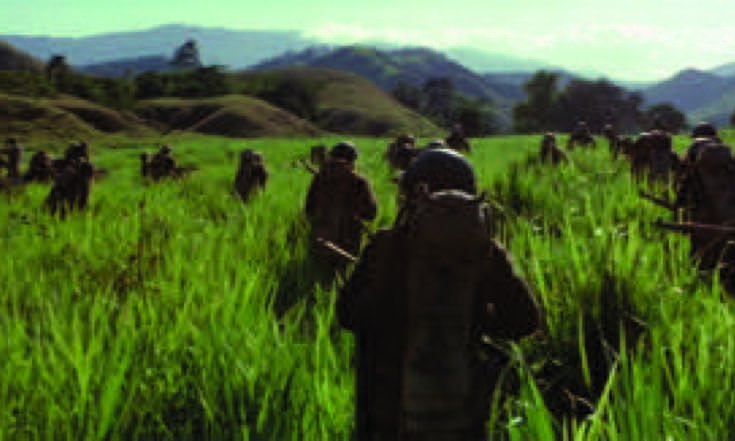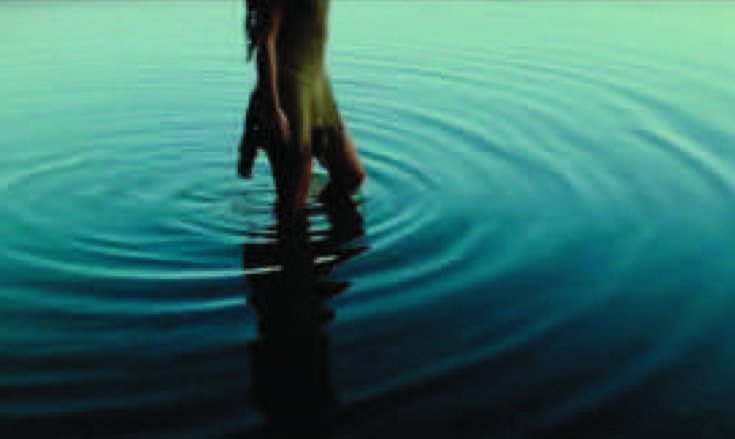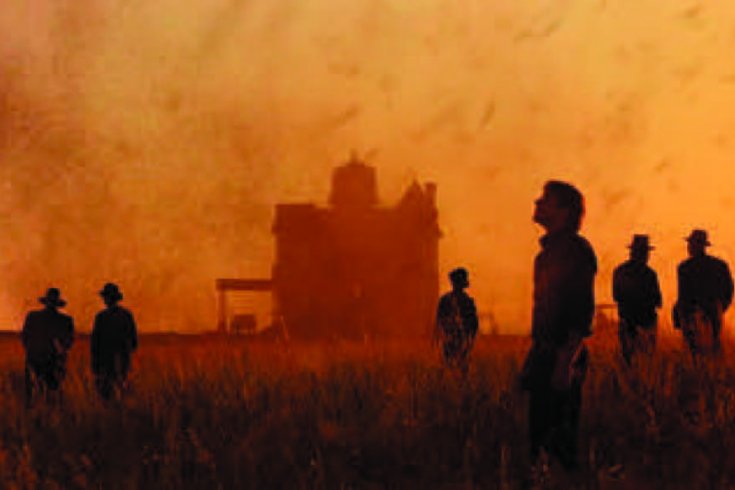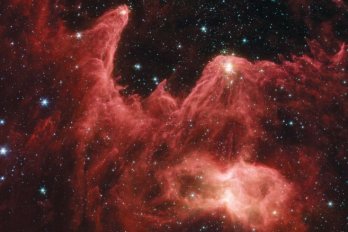The very notion of a man who translated Martin Heidegger’s The Essence of Reasons into English being allowed to film mega-budget Hollywood movies starring George Clooney, John Travolta, and Colin Farrell is enough to make some of us believe there’s justice of some rough kind in the world. Terrence Malick grew up in Oklahoma and Texas, the son of an oilman, and, after graduating Phi Beta Kappa from Harvard, won a Rhodes Scholarship to study philosophy at Oxford. He was well embarked on completing his doctorate on Wittgenstein, Kierkegaard, and Heidegger and their conceptions of the world when he fell out with his advisor, Gilbert Ryle. He returned to the United States to teach philosophy at the Massachusetts Institute of Technology, to dabble in journalism at the New Yorker, and to go through the inaugural program at the American Film Institute in Los Angeles. He made his first feature-length film, Badlands, in 1973, and won instant comparisons with the other bright new wonder of the day, Steven Spielberg, who would release his feature-film debut, Sugarland Express, the following year. In the thirty-three years since, Malick has made exactly three more movies and given not a single interview.
Around such a man, the Thomas Pynchon of the modern cinema, rumours inevitably cluster. He lived in Paris for many years, and studied Buddhism in the Himalayas, people say. He was all set to make a movie based on the Jerry Lee Lewis story, which is less surprising than it sounds if you recall that Lewis is said to be possessed and plays out the all-American tale of devils in the wilderness speaking through a graduate of the Southwestern Bible Institute and cousin of Jimmy Swaggart. He considered filming Sir Gawain and the Green Knight. In an industry where the important thing is to keep your name and face in the news, Malick went twenty years between his majestic second film, Days of Heaven, in 1978, and his third, The Thin Red Line, a brooding meditation on the idea that “We’re dirt” and “We’re meat.” The actors who work with him are always asked to comment on the mystery surrounding him, and tend to use words like “very, very shy” and “a very gentle spirit.” Nick Nolte grumbled that all Malick was interested in was light—and indeed, unbeknownst to the studio, he filmed the whole of The Thin Red Line in “the magic hour” of dusk.
Malick does for the cinema what that other uprooted laureate of West Texas, Cormac McCarthy, does on the page. Both construct grand, flawlessly beautiful canvases on which scenes of the most fearful violence play out. Both plainly believe that God has given man a bounty, especially in the promised land of America, and yet men squander their blessings by going where they should not go. Humans are no more than disposable ants in their landscapes, pawns with which such abstract forces as nature and fate and time fiddle. In Malick’s most recent film, The New World, 2005, it is fair to say that nothing happens in its almost two and a half hours. Yet what the film underlines is that he is a plains mystic, much like McCarthy, who finds in the American grain the charred ashes of the paradise we’ve lost, and the haunted echoes of the possibility of recapturing it again.
I hurried off to the Cineplex as soon as The New World arrived in my town, knowing that Malick movies are as rare as comet sightings. Very soon, the handful of other heads in the theatre seemed to be nodding off, as voice-overs played out the arrival of British settlers in seventeenth century Virginia, the romance of John Smith and Pocahontas, and then the Indian maiden’s transportation to the British court in sentences so uninflected at times, so unfallen, that I was reminded that visionaries pay a price for living so far from the daily world. Yet when the credits came up, I could hardly move from my chair, so strongly had I been taken, now and then, to the heavens.
Five days later, I was back at the Cineplex, confident that The New World would soon disappear from the big screen forever. What was it that made me return so soon, I wondered, to a film that had only transported me at moments Perhaps it was the very spaciousness of the canvas, the gravitas of its intention, the fact that its maker is so clearly working from vision more than mere observation. Where the typical contemporary filmmaker crafts exquisite New Yorker short stories on celluloid, Malick throws up dramas of darkness and light in an eternal battle worthy of Herman Melville. His films represent not so much different perspectives on the world we know as a whole new way of seeing and thinking that urges us to take things in more slowly and to put wonder before information and nothing before stillness.
But more than that, they speak a different kind of language. A few weeks after revisiting The New World, I went to see Sigur Rós, the Icelandic post-rock band, play in Osaka. Many of the band’s songs are in a made-up language called Hopelandic, and therefore bypass the realm of words and sense entirely, to speak to something deeper. From the first chords—the band’s four members silhouetted behind a gauzy white curtain, just shadows playing notes—I realized I was in a different, rarely visited part of myself. The mind was stilled and something else was awakened, in heart and even soul. Tears came as when we see a home we never quite knew we had. A lofty claim, perhaps, but one that began to explain to me what Malick is about and how he affects a few of us in ways we can barely articulate. He offers us a way out of the increasingly claustrophobic moment, and into something that feels less passing. Light and words and the natural world all point to a grander silence.
We are all a part of nature, Malick tells us over and over again, feral and vicious and just occasionally unfallen; we are like ellipses in a sentence that some larger force is completing. People in his films are indistinguishable from the creatures, the elements all around them: they are figures moving through grass taller than themselves, silent outlines seen semaphoring in the distance, scarecrows in a landscape that pulses like a living web all around them. We hunger for more, though; we connive, and hatch designs to increase our standing in the world. And as soon as we attempt to rise above our station, to disrupt the larger pattern, we are lost (or exiled from paradise) forever. Hubris, as the Greeks called it: an inability or refusal to live with what we’ve been given. We hunger for Eden, or a greater part of Eden, and so lose the Garden entirely.
” We rise, we rise,” the romanticized Indians in The New World say, but for them it is a rising into spirit, “towards the light,” as trees and saplings rise; it is a rising into the sky or heavens in which we lose ourselves in something greater. The words that Pocahontas teaches John Smith in their pre-fallen courtship in the film are for sky, for sun, for water, and then for something that he never even bothers to translate, though it could be wind—or movement or the spirit of the universe itself.
People rise to dissolve in Malick’s vision, but never to become greater humans; they are to all intents and purposes like the hawks or wolves that monitor his landscapes, agents of a larger order we are too bestial to apprehend. The shock of a Malick movie is that in frame after frame it will show no action or external event, but birds in the sky, implacable above us, fish in the water, or the movement of wind across a field. As soon as his people try to civilize themselves—a fourteen-year-old waif enters a dancing school in Days of Heaven, Pocahontas is made to put on finery by English settlers in Virginia—they are gone forever, like dogs who put on three-piece suits and sit on chairs before candlelight for dinner. Our true way is vagrant, among the dirty-chinned, snarling, scabrous creatures who drawl and mumble through his films, or, in the case of The New World, among the “naturals,” as he carefully calls the natives, who still exist in a latticework of trees and light.
Malick loves gates because he is fascinated by the places where worlds intersect, the parts where we can go into either a higher or lower realm. The most startling image in Days of Heaven is a shot of a black train under cloudless, newborn blue skies, puffing over a suspension bridge and carrying the main characters into a new world. Not much later, on rough, jolting carriages, the film’s three main characters are taken through an ancient-looking gate that might as well announce, “Abandon human life, all ye who enter here.” Even after they become part of the rolling plains of a farm out of time, trains, planes, and cars keep encroaching on their agrarian rites as if to yank them back into the industrial world, the world of linear time.
Malick is a descendant of Emerson and Thoreau, and their liberating sense of American possibility; the New World is the aboriginal place, this Midwesterner returned from Oxford and Paris is here to tell us, where, ideally, we can recover a sense of glory that should not be tampered with. His subject is what Emerson called the Oversoul, and how the fields of America, the great tabula rasa at the heart of the New World, are the means by which we step back into the world of myth. The New World is, in fact, quite similar to Pocahontas, a virginal creature wooed and then corrupted by visitors from exhausted Europe; though, crucially, she never loses entirely her sense of where she came from.
Malick’s latest movie, however, suffers from the absence of the wry, vivid, scuffling narrative of the fourteen-year-old Linda Manz in Days of Heaven, which gave the film the salt and tang of Huck Finn, and grounded its otherworldly flights. The mystic, more than anyone, needs irreverence to keep him honest. The New World also lacks something of the randomness—the wandering dialogues, the hobo dances—of that earlier film, which compressed the entire Biblical story of Abraham and Sarah and the Pharaoh into ninety minutes of American Greek drama. But Malick is still gazing on sibylline old languages (it was Hebrew in Days of Heaven, it is Greek in Oxford’s Bodleian Library in The New World), still leading us into ceremonies and archetypal rites that bring us into the world of the “dread Day of Judgment.” The visionary, you could say, keeps tilling the same soil in order to deepen his vision, not needing to move laterally, but always pushing his single impulse farther and farther. His groundlings are residents of an Underworld, one feels, even as the England that Pocahontas is taken to becomes a garden of tamed nature and ordered hedges that contrasts, almost too tidily, with her natural home.
There is less concreteness in The New World than in the earlier pictures, less of an immediate sense of the “bone yard” that Linda Manz describes along the edges of rivers and forests in Days of Heaven, the “floating graveyard” that might be Ahab’s ship in The Thin Red Line. There is less mobility in Malick’s portrait of America as the spiritual home of new horizons, the return to a green world of cycles and abundance. The camera roams and glides down a river, as before, but there’s an inertness to what it sees, less of a sense of the life that’s on the bank. The New World can feel more like a mapping of Heaven than a journey there.
Yet what Malick does superbly in his latest work is offer us a vision of the apocalypse at home; he bodies forth and enters the naturals so intensely that we see how they can link us to the world of opossum and coyote, and even bring us back to a network we’ve fallen out of. Their prancing, cuckooing figures, weird with animal sounds, totemic masks, chanting rituals, promise to colonize us with innocence; their bodies dart and swarm through the trees, looming up out of the undergrowth or appearing around rocks as if to take us to a primal order. We feel the pulse, each time we cross the frontier between the native world and the colonized, of the difference between living in a world of presences and living in a world of death.
The mystic’s gamble is a ruthless one: in return for letting him carry us out of the everyday scheme of things, he will show us the web that lies above and behind us, the ocean into which we dissolve as drops. We live on two levels at once, the Dalai Lama says in The Universe in a Single Atom, and the mystic’s aim is to take us out of “conventional reality,” all event and personality and chatter, into silence and space, the hidden plotting of “ultimate reality.” Malick’s post-human movies offer us none of the consolations of daily life, none of the solace even of morality; they bring us simply, as in Dante or Melville, to the landscape of the soul.
“Who are you Who are you” each of the three lovers in The New World asks, and the voices that keep overlapping on the soundtrack begin to suggest the voices in our heads, as we play out, each one of us, the almost daily struggle between the angels and the beasts in us. “What do you dream of” Pocahontas’s new English husband asks her, as if concerned only with essentials. “I like grass,” she says, much as Linda Manz did in Days of Heaven, and, if those not won over to the Malick universe will say that Pocahontas is just stoned, those who sign on for his adventure will see her response as the right—the natural—answer. As in Sigur Rós again, the sense of voices all around, not always meaning something, takes us into the realm of dream.
Beauty will lift the soul into the heavens: that is the impenitent, almost sacrilegious promise of a Terrence Malick film. Many, many movies these days are beautiful—more and more—but in no others that I’ve seen is beauty used as an actual promise, a force, almost a main character. Few other films dare to try to invoke a presence of the divine so strong that beauty seems its instrument. Malick’s aim is to take us back to the time when man and what’s beyond man had a contract—the world of Mozart or the Renaissance painter—and he humbles me, shakes my heart with his cathedrals of light through the trees. Then he makes my tears real and deep with the philosophical weight that lies behind his images, the insistent questions about how we get back to “those other shores, the blue hills.”
He cracks me open, in fact, in ways that make other films of the day seem very small. Instead of characters he gives us fire, water, soil, and sky, and instead of dialogue he gives us a perpetual dusk, grunts scrounging to the sound of the final movement of Fauré’s Requiem, In Paradisum. It is as if in film—just the play of light, a scan across a lake, a wolf suddenly appearing at the crest of a moonlit hill—he finds an ancestral form that rhymes with the very promise that first brought pilgrims to America. Malick is the best hope we’ve got, I find myself believing, because hope, the best in us, is what keeps dogging and haunting those savages, in the light.








